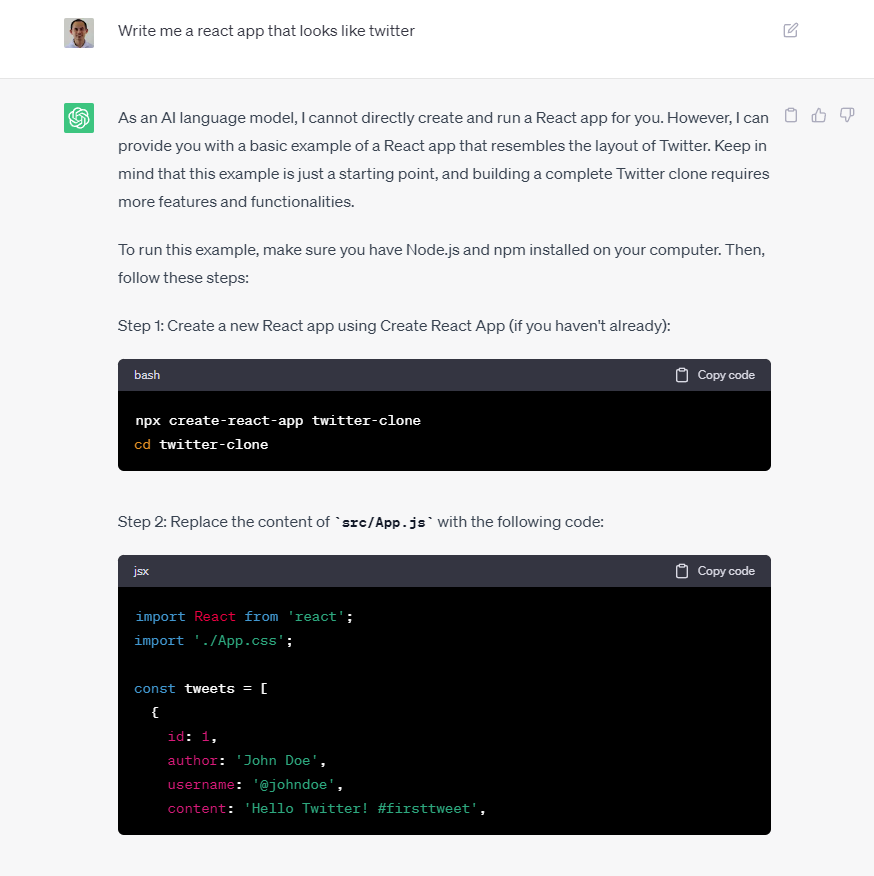Understanding ChatGPT vs GitHub Copilot for developers
Chatbot or IDE-based Autosuggest
This post is current as of August 2023
Trying to figure out how this “AI thing” can improve your productivity as a developer but don’t know where to start? Don’t worry- we’re here with a quick overview of the two most popular ChatGPT powered tools for coders: ChatGPT and GitHub Copilot!
TLDR
Here’s how the two products compare:
We go into more detail about each of these categories in the next few sections.
How each product positions itself
ChatGPT is a AI powered chatbot that allows users to get answers via conversational interactions. It’s designed to converse about and answer general purpose queries and so is not focused on software development specifically, but can be used by developers as almost like an interactive stack overflow chatbot to debug code and provide instructions about general software-related questions, like how to get deploy an app on AWS.
In contrast, GitHub Copilot is targeted only at developers and markets itself as an “AI pair programmer”. What this means in practice is that Copilot auto-suggests and writes code either based on code you’ve written or by based on your comment describing what you want. It integrates directly into major IDEs, so you interact with it in your native coding environment. Github says it works for most languages, as well as for SQL queries.
Who offers each and when was it released?
OpenAI offers ChatGPT in several different versions: free, ChatGPT plus, and API access. Additionally, OpenAI has a suite of other products like Dall-E (AI powered image generation) and Whisper (speech to text and language translation), each purchased separately. While ChatGPT was originally launched free, OpenAI released the paid option named ChatGPT Plus in Feb 2023.
GitHub, owned by Microsoft, offers Copilot. Its ownership by Microsoft is important to realize because Microsoft has in total invested $13B in OpenAI. In turn, OpenAI develops OpenAI Codex, which is the AI model behind Copilot. OpenAI Codex is specifically built to generate code as output based on natural language inputs.
So both products use similar foundational technologies from OpenAI, but have models tuned for different purposes.
What are the main competitor products?
There are several competitors for ChatGPT: Google offers Bard, Meta offers LLaMa, and Baidu offers Ernie Bot. We plan to cover these in future posts, but the key takeaway is that these are similar offerings to ChatGPT, each with its different strengths and weaknesses.
Pragmatic Engineer has a good list of competing products for both ChatGPT and Copilot,
Analogies
I’ll attempt a few simplistic analogies here.
Think of how you’d use ChatGPT for coding as akin to “Google searching for stack overflow tips,” but in dialogue form, and with much less confidence or crowd-based validation of the responses. What I mean by that is that you don’t have people arguing and upvoting/downvoting responses, which give you some indication of what is more or less accurate. And when you use ChatGPT in this way you’re only using a very narrow slice of what it can do, since it’s not purpose built for coding. Here’s an example response if I ask ChatGPT (free) to write a Twitter clone in React:
Copilot is akin to autosuggest on steroids. It’s also good for creating boilerplate code you can quickly modify, which is especially useful if you’re an experienced developer that can easily spot any errors and what needs to be changed.
Pricing and what you get
Prices as of August 2023 are:
$10/month or $100 annually for GitHub copilot, no free option but there is a 30 day trial (this is independent of and does not require a GitHub pro subscription)
$20/month for ChatGPT Plus, with free option. Benefits of Plus over free are general access even peak times, faster response times, and access to new features and models. For example, ChatGPT 4 is only available via Plus.
You can also pay for API access to ChatGPT, which is its own pricing category. We won’t discuss that here since it’s targeted at businesses looking to build integrations.
In future posts, we plan to dive into specific uses cases for each product, along with limitations and things to be aware of especially if you’re using them in a corporate setting. Thanks for reading, and stay tuned!



